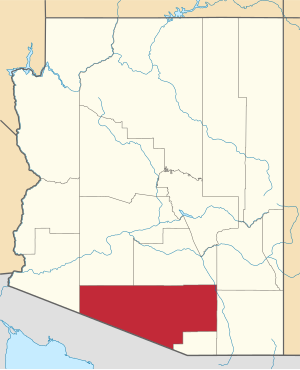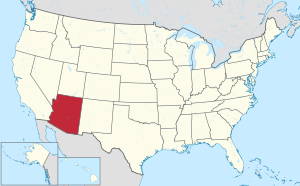Pima County | |
|---|---|
 | |
 Location within the U.S. state of Arizona | |
 Arizona's location within the U.S. | |
| Coordinates: 32°03′55″N 111°49′15″W / 32.06528°N 111.82083°W | |
| Country | |
| State | |
| Founded | November 9, 1864 |
| Named for | Pima people |
| Seat | Tucson |
| Largest city | Tucson |
| Area | |
| • Total | 9,189 sq mi (23,800 km2) |
| • Land | 9,187 sq mi (23,790 km2) |
| • Water | 2.1 sq mi (5 km2) 0.02% |
| Population (2020) | |
| • Total | 1,043,433 |
| • Estimate (2023) | 1,063,162 |
| • Density | 110/sq mi (44/km2) |
| Time zone | UTC−7 (Mountain) |
| Congressional districts | 6th, 7th |
| Website | www |

Pima County (/ˈpiːmə/ PEE-mə) is a county in the south central region of the U.S. state of Arizona. As of the 2020 census, the population was 1,043,433,[1] making it Arizona's second-most populous county. The county seat is Tucson,[2] where most of the population is centered. The county is named after the Pima Native Americans, also known as Tohono O'odham, who are indigenous to this area.
Pima County includes the entirety of the Tucson Metropolitan Statistical Area, and it is the third largest metropolitan area in the Southwestern United States.
Pima County contains parts of the Tohono O'odham Nation, as well as all of the San Xavier Indian Reservation, the Pascua Yaqui Indian Reservation, Organ Pipe Cactus National Monument, Ironwood Forest National Monument and Saguaro National Park.
The vast majority of the county population lies in and around the city of Tucson, filling much of the eastern part of the county with urban development. As Arizona's second-largest city, Tucson is a major commercial and academic center. Other urban areas include the Tucson suburbs of Marana, Oro Valley, Sahuarita, South Tucson, and Green Valley. The rest of the county is sparsely populated; the largest towns are Sells, the capital of the Tohono O'odham Nation, and Ajo in the county's far western region.
- ^ "State & County QuickFacts". United States Census Bureau. Retrieved September 27, 2022.
- ^ "Find a County". National Association of Counties. Retrieved June 7, 2011.
